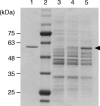Improved production of poly(lactic acid)-like polyester based on metabolite analysis to address the rate-limiting step
- PMID: 26267112
- PMCID: PMC4884051
- DOI: 10.1186/s13568-014-0083-2
Improved production of poly(lactic acid)-like polyester based on metabolite analysis to address the rate-limiting step
Abstract
The biosynthesis of poly(lactic acid) (PLA)-like polymers, composed of >99 mol% lactate and a trace amount of 3-hydroxybutyrate, in engineered Corynebacterium glutamicum consists of two steps; the generation of the monomer substrate lactyl-coenzyme A (CoA) and the polyhydroxyalkanoate (PHA) synthase-catalyzed polymerization of lactyl-CoA. In order to increase polymer productivity, we explored the rate-limiting step in PLA-like polymer synthesis based on quantitative metabolite analysis using liquid chromatography mass spectroscopy (LC-MS). A significant pool of lactyl-CoA was found during polymer synthesis. This result suggested that the rate-limitation occurred at the polymerization step. Accordingly, the expression level of PHA synthase was increased by means of codon-optimization of the corresponding gene that consequently led to an increase in polymer content by 4.4-fold compared to the control. Notably, the codon-optimization did not significantly affect the concentration of lactyl-CoA, suggesting that the polymerization reaction was still the rate-limiting step upon the overexpression of PHA synthase. Another important finding was that the generation of lactyl-CoA was concomitant with a decrease in the acetyl-CoA level, indicating that acetyl-CoA served as a CoA donor for lactyl-CoA synthesis. These results show that obtaining information on the metabolite concentrations is highly useful for improving PLA-like polymer production. This strategy should be applicable to a wide range of PHA-producing systems.
Figures



Similar articles
-
In Vitro Analysis of d-Lactyl-CoA-Polymerizing Polyhydroxyalkanoate Synthase in Polylactate and Poly(lactate- co-3-hydroxybutyrate) Syntheses.Biomacromolecules. 2018 Jul 9;19(7):2889-2895. doi: 10.1021/acs.biomac.8b00454. Epub 2018 May 15. Biomacromolecules. 2018. PMID: 29667817
-
Biosynthesis of polylactic acid and its copolymers using evolved propionate CoA transferase and PHA synthase.Biotechnol Bioeng. 2010 Jan 1;105(1):150-60. doi: 10.1002/bit.22547. Biotechnol Bioeng. 2010. PMID: 19937726
-
Engineered Corynebacterium glutamicum as an endotoxin-free platform strain for lactate-based polyester production.Appl Microbiol Biotechnol. 2012 Mar;93(5):1917-25. doi: 10.1007/s00253-011-3718-0. Epub 2011 Nov 30. Appl Microbiol Biotechnol. 2012. PMID: 22127753
-
Biosynthesis of lactate-containing polyesters by metabolically engineered bacteria.Biotechnol J. 2012 Feb;7(2):199-212. doi: 10.1002/biot.201100070. Epub 2011 Nov 7. Biotechnol J. 2012. PMID: 22057878 Review.
-
Biosynthetic polyesters consisting of 2-hydroxyalkanoic acids: current challenges and unresolved questions.Appl Microbiol Biotechnol. 2013 Sep;97(18):8011-21. doi: 10.1007/s00253-013-5120-6. Epub 2013 Aug 17. Appl Microbiol Biotechnol. 2013. PMID: 23955470 Review.
Cited by
-
Production of D-lactic acid containing polyhydroxyalkanoate polymers in yeast Saccharomyces cerevisiae.J Ind Microbiol Biotechnol. 2021 Jul 1;48(5-6):kuab028. doi: 10.1093/jimb/kuab028. J Ind Microbiol Biotechnol. 2021. PMID: 33899921 Free PMC article.
-
Biomimetic natural biomaterials for tissue engineering and regenerative medicine: new biosynthesis methods, recent advances, and emerging applications.Mil Med Res. 2023 Mar 28;10(1):16. doi: 10.1186/s40779-023-00448-w. Mil Med Res. 2023. PMID: 36978167 Free PMC article. Review.
-
Disruption of poly (3-hydroxyalkanoate) depolymerase gene and overexpression of three poly (3-hydroxybutyrate) biosynthetic genes improve poly (3-hydroxybutyrate) production from nitrogen rich medium by Rhodobacter sphaeroides.Microb Cell Fact. 2019 Feb 26;18(1):40. doi: 10.1186/s12934-019-1088-y. Microb Cell Fact. 2019. PMID: 30808422 Free PMC article.
-
Microbial biosynthesis of lactate esters.Biotechnol Biofuels. 2019 Sep 20;12:226. doi: 10.1186/s13068-019-1563-z. eCollection 2019. Biotechnol Biofuels. 2019. PMID: 31548868 Free PMC article.
-
Microbial Production of Biodegradable Lactate-Based Polymers and Oligomeric Building Blocks From Renewable and Waste Resources.Front Bioeng Biotechnol. 2021 Feb 4;8:618077. doi: 10.3389/fbioe.2020.618077. eCollection 2020. Front Bioeng Biotechnol. 2021. PMID: 33614605 Free PMC article. Review.
References
-
- Fukui T, Chou K, Harada K, Orita I, Nakayama Y, Bamba T, Nakamura S, Fukusaki E. Metabolite profiles of polyhydroxyalkanoate-producing Ralstonia eutropha H16. Metabolomics. 2014;10(2):190–202. doi: 10.1007/s11306-013-0567-0. - DOI
-
- Jung Y, Park J, Lee Y. Metabolic engineering of Alcaligenes eutrophus through the transformation of cloned phbCAB genes for the investigation of the regulatory mechanism of polyhydroxyalkanoate biosynthesis. Enzyme Microb Technol. 2000;26(2-4):201–208. doi: 10.1016/S0141-0229(99)00156-8. - DOI - PubMed
-
- Kalinowski J, Bathe B, Bartels D, Bischoff N, Bott M, Burkovski A, Dusch N, Eggeling L, Eikmanns BJ, Gaigalat L, Goesmann A, Hartmann M, Huthmacher K, Kramer R, Linke B, McHardy AC, Meyer F, Mockel B, Pfefferle W, Puhler A, Rey DA, Ruckert C, Rupp O, Sahm H, Wendisch VF, Wiegrabe I, Tauch A. The complete Corynebacterium glutamicum ATCC 13032 genome sequence and its impact on the production of L-aspartate-derived amino acids and vitamins. J Biotechnol. 2003;104(1-3):5–25. doi: 10.1016/S0168-1656(03)00154-8. - DOI - PubMed
LinkOut - more resources
Full Text Sources
Other Literature Sources

